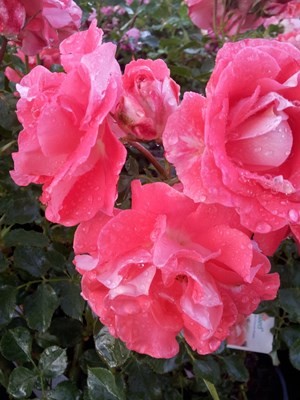China rose
(Rosa indica)

Description
Rosa chinensis, known commonly as the China rose, Chinese rose, or Bengal rose, is a member of the genus Rosa native to Southwest China in Guizhou, Hubei, and Sichuan Provinces. The first publication of Rosa chinensis was in 1768 by Nikolaus Joseph von Jacquin in Observationum Botanicarum, 3, p. 7, p. 55. It is a shrub that reaches 1–2 m and grows in hedges or forms thickets. The leaves are pinnate, have 3–5 leaflets, each leaflet 2.5–6 cm long and 1–3 cm broad. In the wild species (sometimes listed as Rosa chinensis var. spontanea), the flowers have five pink to red petals. The fruit is a red hip 1–2 cm diameter. The strong, stalk-round branches have an almost bare, purplish-brown bark and there may be many to no curved, stocky, flat spines. The alternately arranged leaves are divided into petiole and leaf blade and a total of 5 to 11 inches long. The petiole and the rhachis are sparsely spiked and glandular-fluffy hairy. The pinnate leaf blades usually have three or five, rarely seven pinna leaflet. The leaflets are at a length of 2.5 to 6 centimeters and a width of 1 to 3 centimeters wide ovate or ovate-oblong with weak-rounded or broad-wedge-shaped base, more or less long tapered upper end and sharply sawn edge. The leaf top is shiny dark green and leaves are almost bare. The stipulesare fused with the petiole on most of their length. The free area of the stipules is rooted, having entire margins with pointed upper end and often glandular-fluffy hairy. Inflorescence The flowering time ranges in China from April to September. Rarely, the flowers are solitary, usually four or five bundles together. The 2.5 to 6 cm long pedicel is hairy almost bald or glandular-fluffy. The one to three bare bracts are linear with a pointed upper end and smooth or glandular margin. The flowers have a mild fragrance. The hermaphrodite flowers have radial symmetry with a diameter of 4 to 5 centimeters and are divided with double perianth. There are cultivated forms with simple to more or less strongly filled flowers, which are also wild in China and other areas of temperate latitudes. The bald flower cup (hypanthium) is egg-shaped-spherical or pear-shaped. The early dropping sepals are ovate or sometimes foliage-like, simple or lobed with a dished upper end and bald on the underside and hairy on the top shaggy.
Taxonomic tree:







